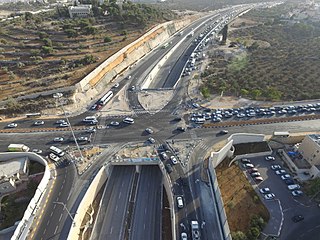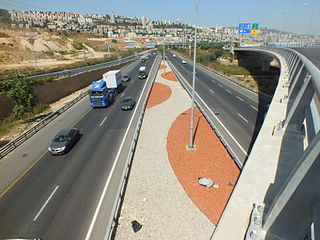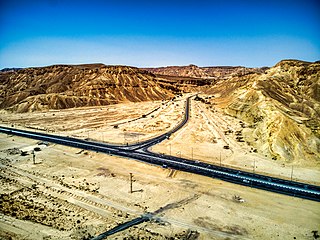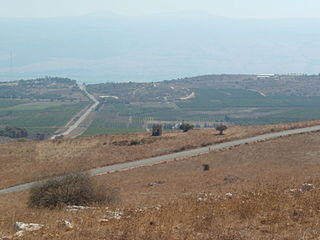
Highway 6, also known as the Trans-Israel Highway or Cross-Israel Highway, is a major electronic toll highway in Israel. Highway 6 is the first Israeli Build-Operate-Transfer road constructed, carried out mainly by the private sector in return for a concession to collect tolls on the highway for a given number of years. It is also one of the largest infrastructure projects undertaken in Israel.

Highway 1 is the main highway in Israel, connecting Tel Aviv and Jerusalem, and continuing eastwards to the Jordan Valley in the West Bank.

Har HaMenuchot is the largest cemetery in Jerusalem. The hilltop burial ground lies at the western edge of the city adjacent to the neighborhood of Givat Shaul, with commanding views of Mevaseret Zion to the north, Motza to the west, and Har Nof to the south. Opened in 1951 on 300 dunams of land, it has continually expanded into new sections on the northern and western slopes of the hill. As of 2008, the cemetery encompasses 580 dunams in which over 150,000 people are buried.

Highway 50, officially called Begin Boulevard and also referred to as Menachem Begin Expressway or Begin Highway, is a north-south urban freeway, through western Jerusalem, named after Israel's sixth Prime Minister, Menachem Begin. Local Jerusalemites simply refer to it as 'Begin'. It enters Area C of the West Bank on the north end and East Jerusalem on both ends.

Highway 2 is an Israeli highway located on the coastal plain of the Mediterranean Sea. It begins as a major arterial road within Tel Aviv, becoming a freeway as it exits the city northward, continuing to Haifa. North of Tel Aviv, the highway is also called The Coastal Highway.

Highway 60 or is a south–north intercity road in Israel and the Palestinian West Bank that stretches from Beersheba to Nazareth.

Highway 431, is a suburban freeway in the south of the Tel Aviv Metropolitan Area in Israel. The freeway connects the Ayalon Highway in the west with Highway 1 in the east. It then continues east into Modi'in as a local road.

Jaffa Road, also called Jaffa Street is one of the longest and oldest major streets in Jerusalem. It crosses the city from east to west, from the Old City walls to downtown Jerusalem, the western portal of Jerusalem and the Jerusalem-Tel Aviv highway. It is lined with shops, businesses, and restaurants. It joins with Ben Yehuda Street and King George Street to form the Downtown Triangle central business district. Major landmarks along Jaffa Road are Tzahal Square, Safra Square, Zion Square, Davidka Square, the triple intersection (Hameshulash) at King George V Street and Straus Street, the Ben Yehuda Street pedestrian mall, the Mahane Yehuda market, and the Jerusalem Central Bus Station. Jaffa Road has been redeveloped as a car-free pedestrian mall served by the Jerusalem Light Rail, as well as by the Jerusalem–Yitzhak Navon railway station directly adjacent to the Central Bus Station.

Highway 22, also known as the Bay Highway, is a suburban freeway in the Haifa metropolitan area connecting downtown Haifa with the city's northern exit to the Krayot. From there it continues northwards as a bypass of the Krayot, providing an alternative route to Highway 4.

Highway 40 is a north-south intercity road in Israel. At 302 km long, it is the second longest highway in Israel, after Highway 90. The highway runs from Kfar Saba in the center of Israel to the Arabah in the south, serving as a main connection between central Israel and Be'er Sheva.

Highway 471, commonly called Maccabit Road, is a suburban expressway in the center of the Tel Aviv Metropolitan Area in Israel. The expressway connects Highway 4 in the west with Route 444 in the east. It is part of a road system planned to provide improved access to Highway 6.
Highway 31 is an inter-city highway in southern Israel. It begins at Lakiya Interchange with Highway 6 at Lakiya. It passes through Hura, Kuseife, Arad, and it terminates at Zohar Junction with Highway 90 south of Neve Zohar just west of the Dead Sea.

The Tel Aviv–Jerusalem railway is a railway line in Israel connecting the cities of Tel Aviv and Jerusalem. The line serves as the main rail link between the two cities, complementing the old Jaffa–Jerusalem railway. As such, the railway is often referred to in Israel as the high-speed railway to Jerusalem to distinguish it from the older, longer and slower line. In spite of that name, the line is not high-speed under the definition used by the International Union of Railways: both its design speed of 200 km/h (125 mph) and its current operational speed of 160 km/h (99 mph) are below the 250 km/h (155 mph) threshold used by the UIC to define high-speed railways, and it is traversed by IR's regular rolling stock instead of the UIC requirement for specially-designed high-speed trains.

Highway 73 is a highway in the Jezreel Valley in northern Israel. It proceeds from the Nahalal junction in the west toward the Adashim junction in the east. It is 12 km long.

Route 899 is an east-west regional highway in the Upper Galilee in northern Israel. For almost its entire length of 63 km, it proceeds parallel to the nearby border between Israel and Lebanon. In Israel, Route 899 is commonly known as the "northern route".

Route 531, is a suburban freeway in the southern Sharon region of Israel, just north of the Tel Aviv Metropolitan Area. The highway begins at Highway 6 and terminates at the Ayalon Highway with an extension to the Coastal Highway.

Highway 45 is the official designation of a 3.3 km stretch of road forming a continuous connection between Route 443 from the Tel Aviv Metropolitan Area and Highway 50 to central Jerusalem and a 1.4 km spur serving the Atarot Industrial Park.

Jerusalem Road 21 is a road beginning at Highway 1 between Ramat Shlomo and Shu'afat northward to Beit Hanina and the Atarot Industrial Park. Plans call for a boulevard with two lanes in each direction. Construction is expected to cost NIS 112 million and was originally expected to be completed by January 2015. The first three sections of the road and part of the fourth section were completed in 2020.

The Har'el interchange was an interchange that connected Highway 1 and Road 3965 near the communities Mevaseret Zion and Motza Illit. The interchange was in the Diamond interchange type, whose bridge is built on the secondary road route and passes over Highway 1, where the traffic is continuous. The interchange opened to traffic in 1971, with the expansion project of Highway 1, which began in the late 1960s. The interchange is named after the Harel Brigade who fought in the area in the 1948 Palestine war.

Highway 333, also known as Ben-Gurion Boulevard, is a highway in West Jerusalem. It is the main entrance to the city through Givat Shaul. In the past, the road was part of Highway 1 until the opening of Yitzhak Shamir Road and the diverting of Highway 1 onto it. However, it is often colloquially still referred to as part of the Jerusalem–Tel Aviv Route.

























